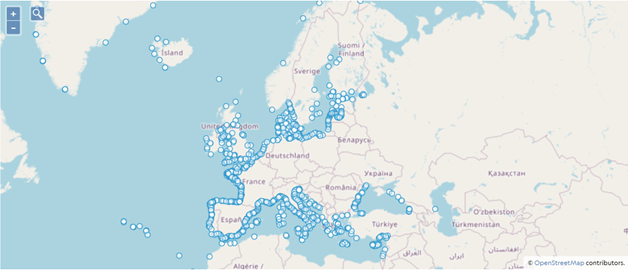EMODnet Chemistry developed and manages the first pan-European Marine Litter Database (MLDB) on the advice of the MSFD Technical Group on Marine Litter and in close cooperation with relevant stakeholders in the EU, such as the European Commission’s Joint Research Centre, the Regional Sea Conventions and the International Council for the Exploration of the Sea. The EMODnet Chemistry Marine Litter Database is a major milestone in the harmonisation of available information at the European level, supporting the establishment of European baselines and threshold values for the MSFD.
Through the SeaDataNet CDI Data Discovery and Access Service, EMODnet Chemistry gives access to beach and seafloor macrolitter data and microlitter data on the sea surface and in sediment from a variety of sources. These include the EU Member States, Regional Sea Conventions, EMODnet partners, and external research or monitoring projects as well as NGOs, citizens, and private companies. Most datasets come from existing monitoring efforts that have published their data in specific databases (e.g. OSPAR and ICES DATRAS).
Through the Products Catalogue, EMODnet Chemistry regularly provides standardised, harmonised and validated data collections for each of the above-mentioned types of marine litter. The differences in the format and reported information might not allow a direct comparison with the source databases.
The partnership is increasingly involved in the the management of other types of marine litter prioritised in the Marine Strategy Framework Directive.
How to submit data
Eager to submit your data? Check out the Marine litter data-flow (see the collapsible boxes below): an intuitive and concise step-by-step scheme on how to share marine litter data using fit-for-purpose guidelines, tools, and software. In particular, this one-page guide provides information on formatting, validating, and submitting data on beach and seafloor macrolitter data, and microlitter data on the sea surface and in the sediment.
Beach Litter Data-Flow
- Format Data
- Use the guidelines and forms for gathering marine litter data;
- Use Marine Litter Manager tool to format beach litter data;
- See Beach litter vocabularies and SeaDataNet Common vocabularies termsto describe beach litter data;
- Visualize the Beaches map to check where the beaches included in the EMODnet database are located;
- Download some Example files
- Validate Data
Use the EMODnet Beach Litter Format Validator to validate data. - Send Data
Send the data to EMODnet Chemistry
Sea Floor Litter Data-Flow
- Format Data
- Use the guidelines and forms for gathering marine litter data;
- Use Marine Litter Manager tool to format data;
- See ICES vocabulariesand to describes Sea Floor litter data;
- Download some Example files
- Validate Data
Use EMODnet SeaFloor Format Validator to validate data. - Send Data
Send the data to EMODnet Chemistry.
Floating and Sediment Micro-litter Data
- Format Data
- Use the Proposal for gathering and managing data sets on marine micro-litter ;
- Use to format data (ODV micro-litter format);
- Use to generate metadata file (CDI);
- Download some example files (floating and sediment).
- Validate Data
Use OCTOPUS software to validate data. - Submit metadata
Populate your CDI metadata and Micro Litter data sets into the SeaDataNet CDI Data Discovery and Access service.
Tools & Vocabularies
Together with the partnership's research and monitoring institutes, the national oceanographic data centres collect and format the available information to populate the EU marine litter database.
To facilitate the submission of marine litter data in a standardised wat, EMODnet Chemistry has developed specific tools to format (syntactically and semantically), and validate marine litter data. They are briefly described below:
Marine Litter Manager
The Marine Litter Manager generates EMODnet beach and seafloor data formats. The software is downloadable on GitHub, where the user manual and dedicated videotutorials are also available.
EMODnet Beach Litter Format Validator
Once the beach litter data are formatted according to the official specifications , data providers can use the Beach Litter Format Validator to verify the correctness and approve EMODnet beach litter files. The tool has been successfully tested with Chrome, Firefox and Edge web browsers.
Seafloor Litter Format Validator
Once the seafloor litter data are formatted according to the official specifications , data providers can use the Seafloor Litter Format Validator to verify the correctness and approve EMODnet seafloor litter files. The tool has been successfully tested with Chrome, Firefox and Edge web browsers.
Beach litter vocabularies
The Beach litter vocabularies list all terms used to describe beach litter data in EMODnet format. This online service allows the user to have an up-to-date database of beach litter vocabularies, which is essential for the interoperability of the data.
Beaches map
Beaches map is a dynamic visualisation of the distribution of beaches (and their codes) contained in the EMODnet Chemistry beach litter database. These beaches have been surveyed either for litter monitoring, cleaning or research. This tool helps to avoid duplicates when recording beach litter data.

ICES vocabularies
ICES vocabularies include all the terms used to describe seafloor litter data in the EMODnet format.
NEMO & MIKADO
NEMO and MIKADO tools enable data centres to format data and metadata files, respectively.
SeaDataNet vocabularies
SeaDataNet Common vocabularies terms include all the terms used to describe microlitter data in the EMODnet format.
